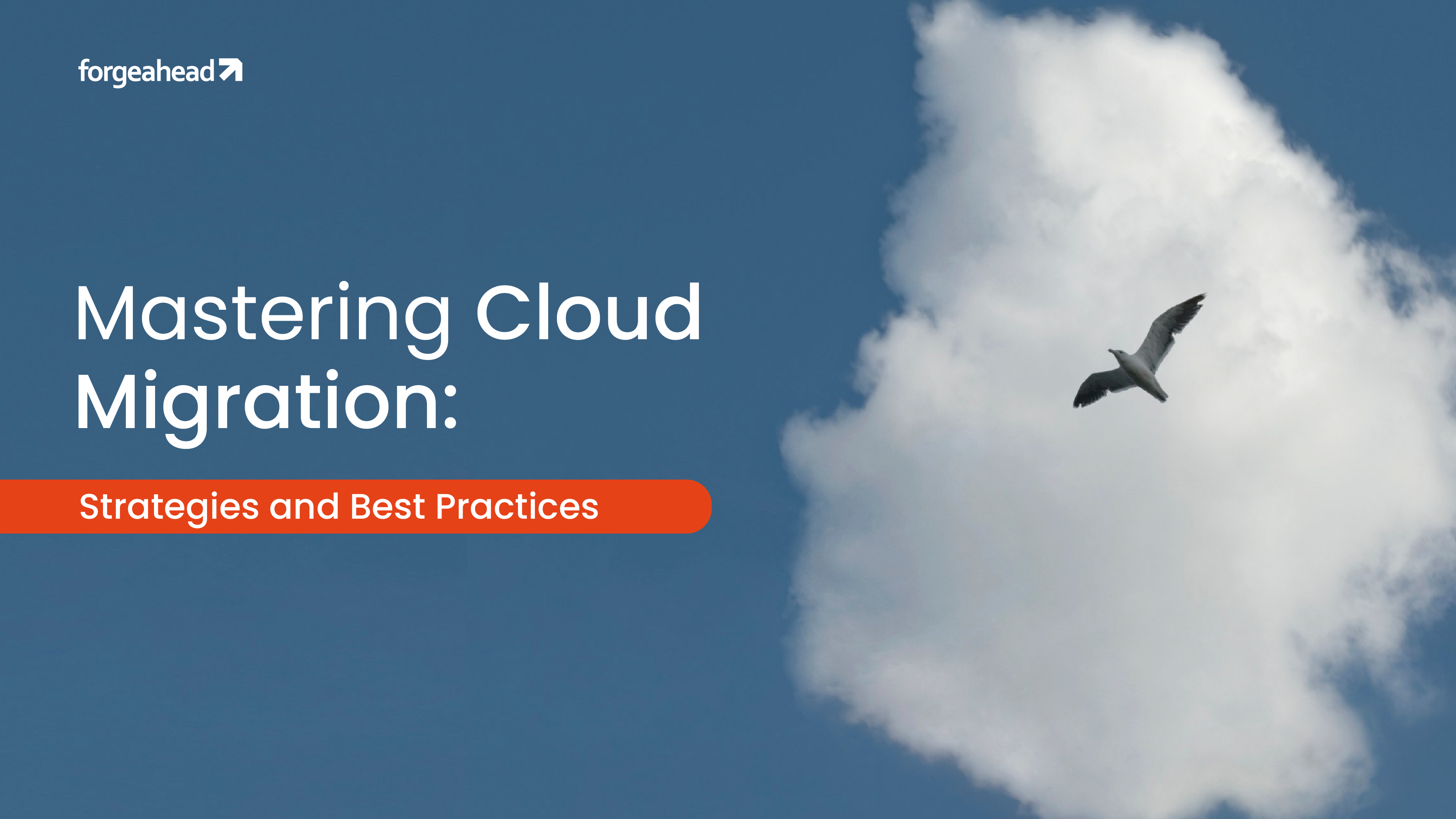Hey there, we’re about to blast off into the cloud – no, not literally.
Picture this: cost savings that’ll make your wallet sing, scalability that stretches like elastic, and agility that’ll leave competitors in the dust. Sounds dreamy, right?
Crafting a cloud migration strategy is like solving a Rubik’s cube blindfolded.
How do you cook up a plan that actually works?
How do you juggle resources without dropping the ball?
And don’t get me started on those integration headaches!
But fear not, this blog is your golden ticket through the cloud maze.
Ready to turn your tech dreams into cloud-powered reality?
What is Cloud Migration?
Before we get into anything – we need to understand what cloud migration is.
Cloud migration is the process of moving digital assets—such as data, applications, and IT processes—from on-premises infrastructure to cloud environments.
This shift can also involve transferring assets from one cloud provider to another, known as cloud-to-cloud migration. Essentially, it’s about relocating your business’s digital operations to a more flexible and scalable environment.
Benefits of Cloud Migration
Migrating to the cloud offers numerous advantages that can transform your business operations:
- Cost Savings: By eliminating the need for physical hardware and maintenance, businesses can significantly reduce IT expenses. Cloud providers offer a pay-as-you-go model, ensuring you only pay for what you use.
- Scalability: Cloud platforms allow you to scale resources up or down based on demand, ensuring optimal performance without over-provisioning. This flexibility is crucial for handling variable workloads and seasonal traffic spikes.
- Improved Performance: With cloud services, you get access to high-performance infrastructure. This ensures that applications run smoothly and efficiently, enhancing user experience and operational efficiency.
- Disaster Recovery: Cloud providers offer robust disaster recovery solutions, enabling quick data recovery in case of hardware failure or other disruptions. This reduces downtime and ensures business continuity.
- Enhanced Security: Leading cloud providers invest heavily in security measures, including data encryption, identity management, and regular security updates. This helps protect your data from cyber threats and unauthorized access.
- Accessibility: Cloud services can be accessed from anywhere with an internet connection, supporting remote work and collaboration. This accessibility ensures that your team can work efficiently, regardless of their location.
- Automatic Updates: Cloud providers manage software updates and security patches, ensuring your systems are always up-to-date. This reduces the burden on your IT team and ensures you are using the latest technology
Why Is Cloud Migration Crucial for Modern Businesses?
In today’s fast-paced world, being quick on your feet is key. That’s where cloud migration comes in handy.
Think about it: launching new services faster, beefing up your disaster recovery, and making teamwork a breeze. Plus, with cloud tech, your team can work from pretty much anywhere. Home office? Coffee shop? No problem.
So, here’s a thought to chew on: How could moving to the cloud give your business that extra edge? It might just be the boost you’ve been looking for.
Cloud Migration Strategy Checklist
Creating a robust cloud migration strategy is crucial for a smooth transition to the cloud.
Here’s how to develop an effective plan:
- Planning:
- Importance of strategic planning
- Align migration objectives with organizational goals
- Assess current IT infrastructure and identify key assets for migration
- Resource Allocation:
- Efficiently allocate financial and human resources
- Budget for cloud services, potential downtime, and necessary training
- Assign specific roles and responsibilities to team members
- Risk Management:
- Identify common risks such as data loss, downtime, and security breaches
- Develop a risk management plan with regular backups, data encryption, and a rollback strategy
- Continuously assess and mitigate risks throughout the migration process
- Integration and Compatibility:
- Ensure seamless integration with existing systems
- Conduct thorough testing to confirm compatibility
- Use middleware tools to bridge any compatibility gaps
- Change Management:
- Communicate clearly about the migration’s benefits and impacts
- Provide comprehensive training to staff
- Prepare the team for the transition to ensure a smoother adoption
What is the Strategic Planning and Assessment of Cloud Migration?
Developing a successful cloud migration strategy starts with thorough strategic planning and assessment.
Here’s how to approach it:
Current IT Systems
- Evaluate Infrastructure: Begin by assessing your current IT infrastructure. Identify which applications and data are critical to your operations and their readiness for the cloud. Understanding the existing environment helps in planning the migration process effectively
- Performance Analysis: Conduct performance analysis to determine how well your current systems are functioning and where improvements can be made once in the cloud
Migration Goals
- Set Clear Objectives: Define clear, measurable goals for your cloud migration. Are you aiming to reduce costs, improve scalability, enhance performance, or all of the above? Having specific objectives will guide your strategy and ensure alignment with business needs
- Align with Business Strategy: Ensure that your migration goals support your overall business strategy and growth plans. This alignment is crucial for gaining stakeholder buy-in and achieving long-term success
Structured Plan
- Detailed Planning: Create a detailed migration plan that outlines each phase of the migration process. Include timelines, key milestones, and responsible parties to ensure accountability and progress tracking
- Phased Approach: Consider a phased approach to migration, starting with non-critical applications to minimize risk. Gradually move more essential systems as confidence and experience grow
- Testing and Validation: Incorporate testing and validation steps into your plan to ensure each migrated component functions correctly before fully transitioning to the new environment
What are the Risk Management and Mitigation of Cloud Migration?
Effectively managing and mitigating risks is crucial for a successful cloud migration.
Here’s how to approach it:
Identifying Risks
- Data Loss: Errors in data transfer or integrity issues can lead to data loss
- Downtime: Migration can cause downtime, disrupting operations and affecting revenue
- Security Breaches: Vulnerabilities during migration can expose data to unauthorized access
- Compatibility Issues: New cloud solutions may face integration challenges with existing systems
Mitigation Strategies
- Regular Backups: Regularly backup data to minimize the risk of loss
- Encryption: Protect data in transit and at rest with encryption
- Phased Migration: Start with less critical systems to reduce downtime and gain confidence
- Thorough Testing: Test each stage to identify and resolve issues early, ensuring compatibility
- Security Measures: Use multi-factor authentication and robust access controls to secure data
Monitoring
- Continuous Monitoring: Use tools to track the migration process in real-time and address issues promptly
- Risk Assessment: Regularly assess risks and adjust strategies as needed
- Post-Migration Review: Review the migration process to identify successes and areas for improvement
Challenges, Solutions, and Tools for Cloud Integration
| Challenges | Solutions | Tools |
| Compatibility Issues | Utilize middleware to bridge gaps between different systems, ensuring applications communicate and exchange data effectively | MuleSoft: Connects applications, data, and devices with APIs for seamless integration |
| Data Synchronization | Implement data integration platforms to synchronize and consolidate data from various sources, ensuring consistency and integrity | Dell Boomi: Simplifies connecting applications and data across different environments |
| Security Concerns | Apply strong security protocols, such as end-to-end encryption and secure access controls, and conduct regular security audits and updates | AWS Glue: A managed ETL service that prepares and loads data for analytics, ensuring secure and efficient data handling |
| Compatibility Issues | Use APIs to facilitate seamless communication between disparate systems, ensuring compatibility and data exchange | Apache Camel: An open-source integration framework that supports various systems using enterprise integration patterns |
Case Studies and Real-World Examples of Cloud Migration
Real-life examples of successful cloud migration projects can provide valuable insights and best practices.
Here are two notable case studies:
Example 1: Netflix
Netflix’s transition to the cloud is one of the most well-known cloud migration success stories. Facing rapid growth, Netflix needed a scalable and reliable infrastructure to support its expanding user base. They decided to migrate their entire infrastructure to AWS over several years, a move driven by the need for greater scalability and global reach.
Example 2: Capital One
Capital One embarked on a cloud migration journey to enhance its agility and innovation capabilities. They aimed to move the majority of their applications to AWS, leveraging the cloud to improve security, operational efficiency, and customer experience.
Ending Thoughts
In this blog, we’ve explored the essential components of a cloud migration strategy. We started by understanding what cloud migration is and its critical benefits for modern businesses.
Next, we delved into the development of a comprehensive strategy, emphasizing the importance of planning, resource allocation, risk management, integration, and change management.
Through real-world case studies, we saw how industry leaders successfully navigated their cloud migration journeys and the lessons learned from their experiences.
To ensure a smooth transition and maximize the benefits of cloud computing, it is vital to develop a well-thought-out cloud migration strategy.
By incorporating best practices and learning from successful case studies, your organization can achieve a seamless and efficient migration, positioning itself for future growth and innovation.
Are you ready to transform your business with a robust cloud migration strategy? Start planning today to unlock the full potential of the cloud and drive your business forward. Connect with Forgeahead today.
FAQs
1. What is cloud migration?
Cloud migration is the process of moving digital assets such as data, applications, and IT processes from on-premises infrastructure to cloud environments. It can also involve transferring assets from one cloud provider to another.
2. Why is cloud migration important for modern businesses?
Cloud migration offers numerous benefits including cost savings, scalability, improved performance, enhanced security, and disaster recovery. It also enables businesses to be more agile and responsive to market changes.
3. What are the main challenges of cloud migration?
Key challenges include data loss risk, complexity of implementation, cost management, ensuring business continuity, and addressing security and compliance issues.
4. How can businesses ensure a successful cloud migration?
Successful cloud migration requires thorough planning, efficient resource allocation, risk management, seamless integration, and effective change management. Regular testing and continuous monitoring are also crucial.
5. What are some best practices for cloud migration?
Best practices include starting with a phased approach, conducting regular backups, using encryption, automating processes, ensuring compatibility with existing systems, and providing comprehensive training to staff.





